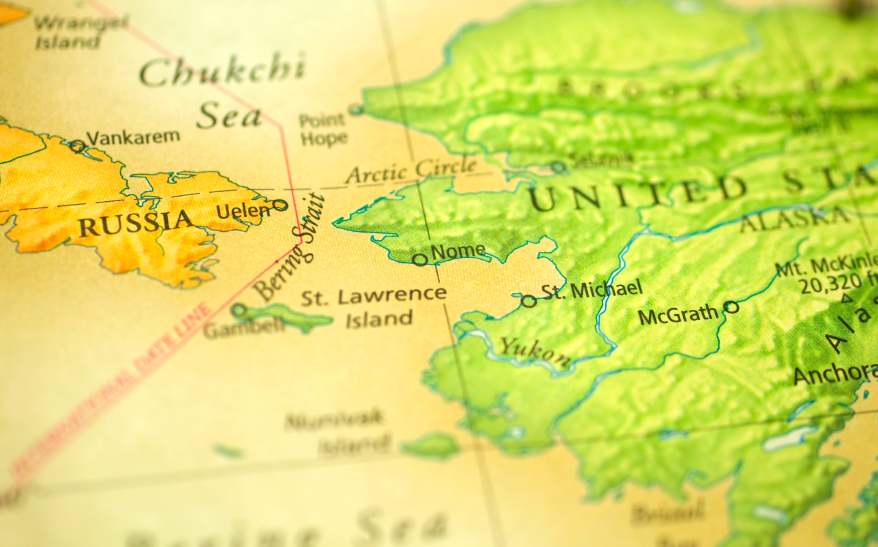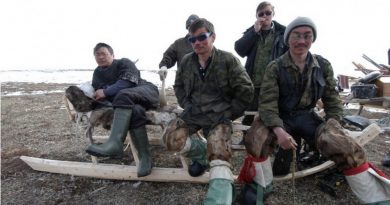Polar Code approval is timely for busy Bering Strait

The Bering Strait, the narrow chokepoint between the Pacific and Arctic Oceans, has been a watery crossroads for millennia.
Skin boats paddled by indigenous residents were followed by commercial whaling ships, which were followed in the 20th century by vessels supporting the newcomers who mined for gold and drilled for oil.
Now, with summer Arctic sea ice dwindling, commercial and resource-extraction ambitions are expanding — and so is Bering Strait ship traffic. Crossings of the straight by large vessels more than doubled from 2008 to 2012, going from about 220 to more than 480, according to the U.S. Coast Guard. And at the Port of Nome, the closest thing the United States has to a full-service Arctic port, vessel use has exploded, from 34 recorded dockings in 1990 to 446 in 2014.
The Bering Strait will likely be an even busier place in the future as shippers seek to take advantage of Arctic opportunities. “That’s where the action’s going to be,” said Kevin Harun, Arctic program director with Pacific Environment
So a set of new international vessel standards — the Polar Code, which won final approval last week from the International Maritime Organization — is timely for the region.
Raised concerns
Already, a series of marine tragedies, accidents and near-misses have raised concerns.
A Korean cargo ship, the Oriental Angel, caught fire in 2011 off the coast of Russia’s Chukotka Peninsula, killing one crew member. Also that year, a fuel-laden barge went adrift in heavy waves off the Bering Strait village of Wales; control was regained before the vessel grounded. Late last year, a Korean fishing vessel, the Oryong 510, sank in the western Bering Sea off Russia, killing most of the 60-member international crew.
A drifting supply barge, which broke off its tow line in November off Tuktoyaktuk, Northwest Territories, has been pushed by ice and meandered more than 1,300 miles west through Arctic waters. At last report, it was 28 miles off Chukotka, said Ed Page, executive director of the Marine Exchange of Alaska, which is monitoring signals sent by a GPS transponder attached to the vessel. The ship’s owner, Northern Transportation Company Ltd., has promised to retrieve it this summer. Luckily, it has very little fuel aboard and thus is not considered to pose much of a spill risk, Page said. “It’s going to be a pain in the neck getting that barge back, but it’s not an environmental Armageddon or anything,” he said.
On top of that have been some mysterious oiling events, none tied to any specific vessel, that have soiled birds, seals and shorelines in the Bering Strait. Oiled birds and seals were found at St. Lawrence Island in 2012, and dead, oiled birds were also found there in 2013, while anoily sheen was discovered last year at Shishmaref.
It’s uncertain whether the Polar Code could have prevented any of those incidents, experts say. But the code will, when it goes into effect in 2017, impose new standards for crew safety and training and will possibly prevent future problems – perhaps sparing Arctic waters from the pattern elsewhere, which is catastrophe first and protections later, Harun said. “If we can just accomplish some of this stuff before we have a potential disaster, it could be that the Arctic has a different future,” he said.
How will code affect operations?
What the Polar Code will do, once it goes into effect, is ban discharges of oily waste and noxious chemicals in all waters north of 60 degrees latitude, as well as in Antarctic waters; require ice-strengthened hulls and protective ship structures to shield fuel oil from punctures; require mariners to avoid marine mammals; and mandate better safety equipment and training for mariners.
What the Polar Code does not require, at least for Arctic waters, is a shift from heavy fuel oils to cleaner fuels — a change that advocates say would lessen the environmental harm caused by spills, as well as lessen the emissions of soot, also known as black carbon, that darken snow and ice and hasten melt.
That omission deeply disappoints environmentalists, who point to the IMO’s mandate for lighter fuels in Antarctic waters. Allowing continued use of heavy fuel oils in the Arctic “is unconscionable in 2015,” said John Kaltenstein, a marine policy analyst with Friends of the Earth.
A switch to distillates or other less-harmful fuels is technically easy, Kaltenstein said. “We have a fairly simple fix right there,” he said. Switching from heavy fuels would also curb emissions of black carbon, which darken ice and snow and hasten their melt, he said. “For the policymaking world, it’s something we can do in the near term,” he said.
The Polar Code also omits any specific protections for seabirds, which occupy areas that are expected to become heavily trafficked by vessels. It does not spell out any details on spill prevention and response, and it does not address Arctic shipping routes.
Kaltenstein, Harun and others hope new protections can be added to the Polar Code in the future.
Local and regional issues
For the Bering Strait, some environmental and marine-safety issues are being addressed locally and regionally,
The Coast Guard is setting up a shipping-lane system, with draft recommendations released in December. Such a system is long overdue for the region, where more big ships have the potential to clash with small personal and subsistence vessels, experts say.
“I think everywhere else in the world, there are some kind of standards for shipping lanes,” said Nome harbormaster Lucas Stotts.
The shipping-lane plan is part of a larger project examining the idea of a deepwater port in the region, a facility that could be at Port Clarence north of Nome, which until recently housed a Coast Guard navigation station. For now, Stotts said, Nome’s harbor is too shallow to accommodate the very large vessels, so big ships crossing the Bering Strait don’t stop there. “For the Port of Nome, most of the traffic that’s going through there doesn’t have much to do with us,” he said.
The Alaska Department of Environmental Conservation, the Coast Guard and other agencies, meanwhile, are also ramping up their spill prevention and preparedness activities in the Bering Strait region. That effort includes spill drills, like one conducted last year at Port Clarence as part of the Coast Guard’s annual Arctic Shield program. Agency officials learned, through that drill, the value of local knowledge, the DEC’s Bradley Dunker said at an Anchorage conference this week. Locals warned of powerful currents in an area between sand spits, and unsuccessful efforts to set up oil-containment boom confirmed that warning, Dunker said. “When we went out to deploy, we found that there was a 16-knot current,” he said in his presentation at the 12th International Effects of Oil on Wildlife Conference.
The booming offshore gold-mining business in Nome will also see some safety-oriented changes. Starting this summer, the Coast Guard will classify gold-dredge vessels as commercial craft, subject to stricter safety rules that are to be phased in. Up to now, vessels in the eclectic fleet have been considered recreational watercraft.
Related stories from around the North:
Canada: Supply barge adrift in the Arctic for months, Radio Canada International
China: China’s silk road plans could challenge Northern Sea Route, Blog by Mia Bennett
Denmark: IMO completes Polar Code, regulating Arctic and Antarctic shipping, Alaska Dispatch News
Finland: Most luxury cruise liners still dumping sewage in Baltic Sea, Yle News
Iceland: 10 takeaways from the 2014 Arctic Circle Assembly, Alaska Dispatch
Greenland: Study finds increase in litter on Arctic seafloor, Blog by Mia Bennett
Russia: Submariners feed polar bears with garbage, Barents Observer
United States: Ship trouble in the Arctic on the rise: report, Alaska Public Radio Network



